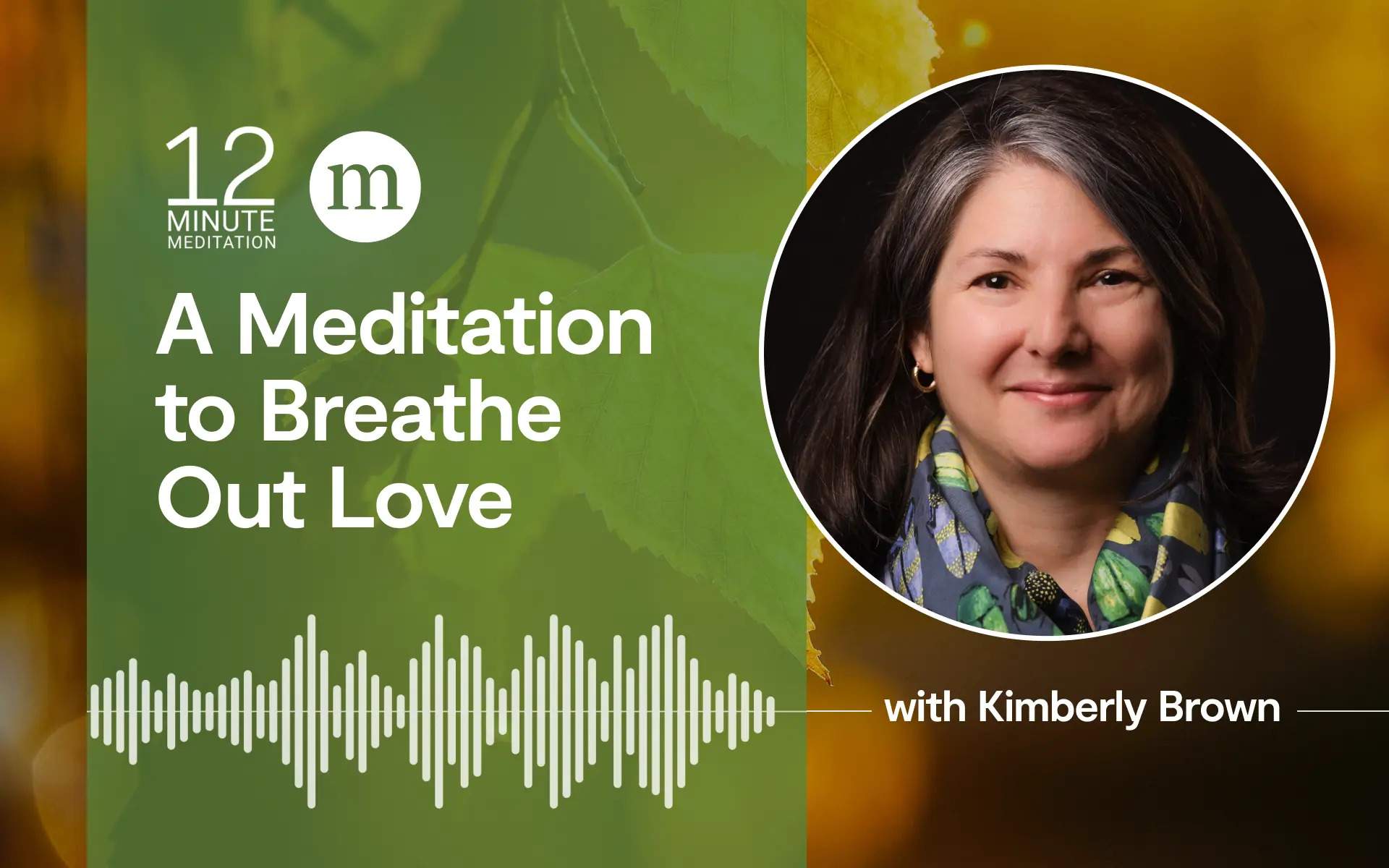Tonglen, sometimes called loving-kindness meditation, is a Tibetan practice of giving and receiving.
In Tonglen, we open ourselves to our entire experience, including what is painful and difficult. We acknowledge our suffering, including the suffering we share with others. Then, we release intentions for peace, healing, and love out into the world.
In today’s meditation, teacher Kimberly Brown guides us through a gentle practice based on Tonglen. This meditation is a space for us to simply experience our struggle, to breathe in any tension or tightness, and to breathe out love, both as a sense of openness and ease, and also as a way of being at peace with ourselves and others.
Note that this practice includes longer pauses of complete silence for reflection and presence. If you want more time, feel free to pause the recording as you go.
A Meditation to Breathe Out Love
Read and practice the guided meditation script below, pausing after each paragraph. Or listen to the audio practice.
Note: This practice includes long pauses of complete silence to give you time to spend in contemplation. If you want more time, feel free to pause the recording as you go.
- If you’ve learned Tonglen before, you may have done it as a visualization. It’s often taught that as you inhale, struggle, and suffer, you can imagine you’re breathing in smoke or darkness. And as you exhale, you can imagine you are exhaling or giving light or clear, fresh air. In today’s meditation, I won’t be using a visualization, but you’re welcome to do that if that makes it more accessible for you.
- To begin, just get quiet and still. Find a place where you won’t be disturbed for about 10 or 15 minutes. And I know you’re on a device because you’re listening to me, but move that device away from you. Don’t check emails or listen to music or anything right now. Take this time, this opportunity to just get quiet and still and pay attention to yourself with kindness.
- You can lie down if you’d like, you can sit, or you could also walk or stand. Notice what’s arising in you right now. You might notice light is entering through your eyes. Smell is touching your nose. Sound is entering your ears, taste entering your taste buds, your mouth. Notice all the sensations of your body, the weight of you. The air on your skin. And notice your breath, allowing yourself to receive your breath.
- Remember, you don’t have to do anything. Just accept your breath, allowing your body to breathe and receive. In the same way, you are allowing yourself to receive the breath and receive light through your eyelids or your eyes, receiving sound through your ears, and receiving thought. You don’t have to think or push anything away, or create anything. Instead, you’re simply allowing all of these arisings to come and to go.
- For the next few minutes, you don’t have to fix anything, and you don’t have to figure anything out. You’re just allowing all of these sensations to come to you and letting them arise and change and dissolve. They’re all going to come and go. If you get caught in a big story or something, that’s okay. You can gently use your breath as a tether to come back and then relax and open up again, just for a couple of minutes.
- After the time for silence, notice where your attention is. For example, notice light entering your eyes, thoughts entering your mind, smell entering your nose, receiving your breath, and taking a moment here to recognize your intention. You have chosen to practice a meditation today. You could be doing probably many other things, and yet you are taking your time and your effort and your compassion and your wisdom to practice in this way. Appreciate your intention, whatever is bringing you to this, knowing that it’s a beneficial motivation and that it is valuable to yourself and others. So please thank yourself. I thank you for being here today.
- Now, bring your attention to your breath. You can place a hand on your heart and on your belly and notice your breath: the rise of your chest and your abdomen as you inhale, and the relaxation, the contraction, as you exhale. Feel your presence. As you inhale, gently allow yourself to feel any places of tightness and stress.
- Allow yourself to notice painful feelings and thoughts. Bring them closer to you, breathing them in. As you exhale, let go of this tension. Relax. Offer yourself ease. Have a sense of space and openness. Continue in this way, very gently drawing in your difficulties, bringing them closer to you like you might be hugging someone you know in distress. And as you exhale, give yourself a sense of peace, a sense of ease, a sense of, It’s okay. Continue this repetition of breathing in your struggles and breathing out a sense of peace and ease and kindness and patience, just for a couple of minutes.
- Again, after the pause, notice where your attention is. If you need to begin again, that’s okay. Gently reconnect with yourself. Inhale your difficulties and exhale a sigh, a softness, and open just for one more minute.
- After this pause, consider for a moment that whatever your struggle is, there are many, many other people struggling in a very similar way. If you have an illness, there are others who are also experiencing that illness. If you’re having financial stress, there’s others experiencing that. If you are experiencing oppression, there’re others experiencing oppression. If you are in a conflict with someone you love, there are others in conflict with people that they love. So I’d like you to start to consider all of these other beings struggling in the same way you are. For example, my father died a couple years ago, and I am considering and thinking of all of the other people on the planet, perhaps even all the animals, who have lost their fathers. So, breathe in, very gently, this struggle, this difficulty that you and others have. You could imagine them or you can just have a sense of this collective difficulty and struggle and pain. Gently breathe it in, and then breathe out relaxation, openness, patience, ease for yourself and for all these others going through something similar.
- Continue this process for as long as you like. If you want more time in silence, just pause the recording. Continue receiving and giving, breathing in difficulty and breathing out love. You can do as many rounds of this as you like.
- When you’re ready, you can let go of the technique and gently allow yourself to rest. Thank yourself for your practice today. I thank you for practicing, for your good sense and for your beautiful heart. You can email me or leave comments if you have questions. Thank you.






